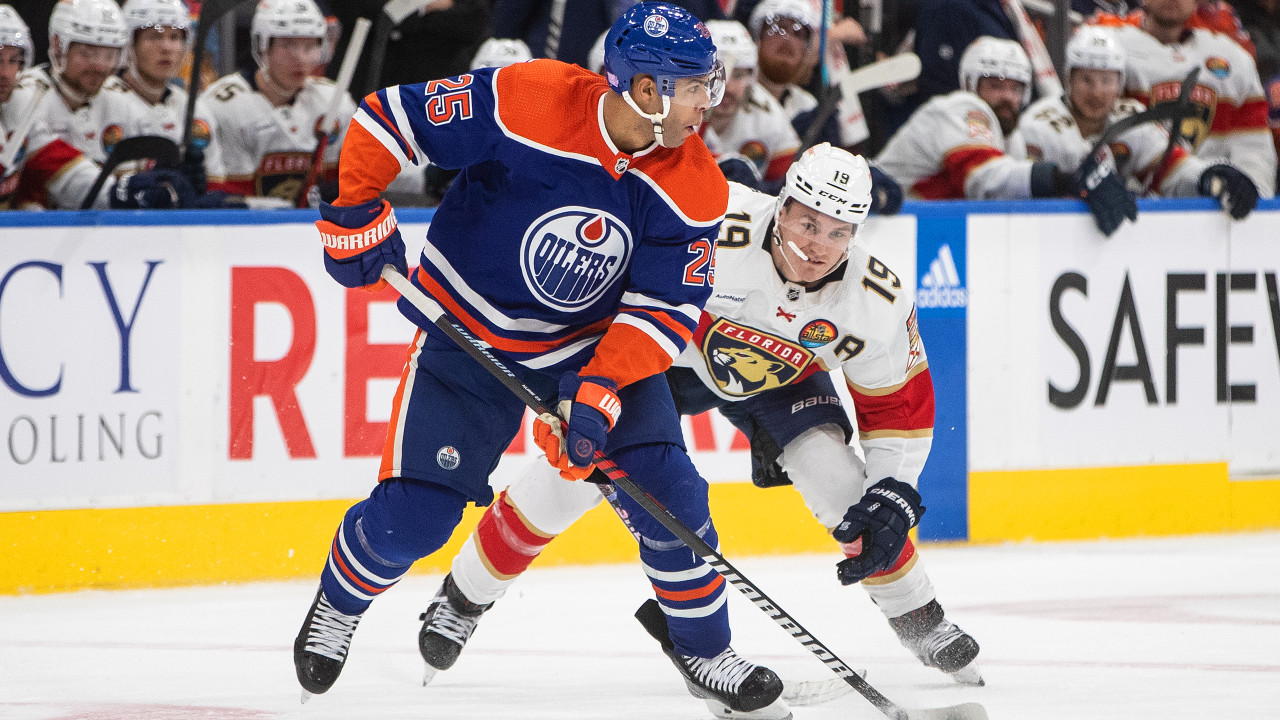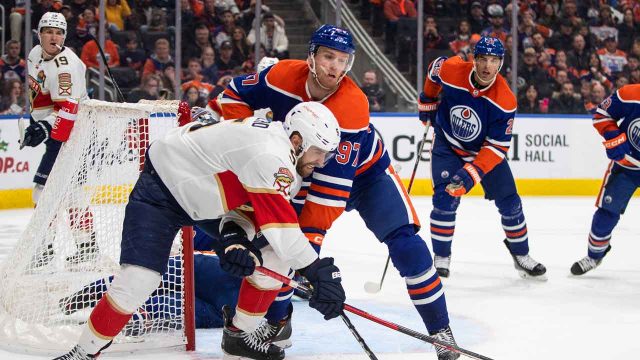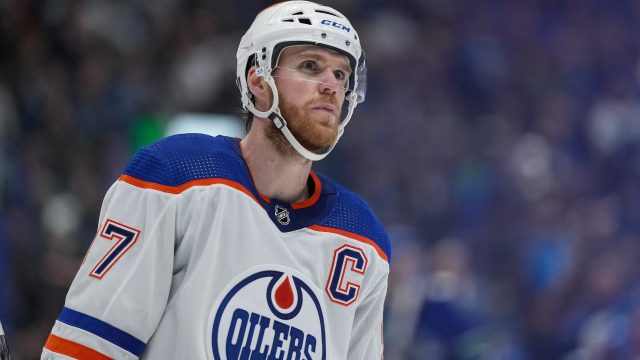
From the moment he first touched NHL ice, first took off with dizzying speed past the ones we thought were the game’s best, Connor McDavid has been barrelling toward this moment.
For the better part of a decade, the Richmond Hill, Ont., kid has been making magic in Oil country, amassing a trophy collection that reads as downright silly: five scoring titles, three Hart trophies, four more MVP nods from his fellow players, and a Rocket Richard Trophy clinched with a 64-goal effort pulled out seemingly just to prove he could.
The most coveted trophy in the game, though, has eluded him — the Stanley Cup that would complete his collection and cement his legacy as one of the greatest players to ever pull on an NHL sweater.
For the first time in his career, McDavid will have his shot at lifting the trophy that matters most. After dispensing with the Los Angeles Kings yet again, outlasting the Vancouver Canucks in an all-Canadian thriller, and taking down the Dallas Stars in their toughest test yet, his Oilers now step on to the league’s biggest stage to meet the Florida Panthers in the Stanley Cup Final.
But the path that led Edmonton back to the Final was paved with far more than McDavid’s greatness. Dominant as the quick-footed phenom has been, the evolution of the rest of the club’s core and the shrewd building of the group around them have been just as essential to the project.
It’s why the Oilers are reaching their first Final after nine years of McDavid at the height of his powers, why they’ve put it all together now and finally earned their shot after flirting with contender status for the past few years.
Make no mistake, the Oilers don’t get here without No. 97 doing what he’s done. But they aren’t here without the myriad other decisions made over the past half decade either. That being the case, on the cusp of the franchise’s most important series in nearly 20 years, let’s rewind and retrace the history of how these Oilers were built.
THE CORE: BUILDING THROUGH THE DRAFT LOTTERY
Ryan Nugent-Hopkins enters the Cup Final as the longest-tenured member of this club, the veteran two-way rock the only holdover from the previous era of Oilers rebuilds.
It was right before Nugent-Hopkins’ arrival that the club’s franchise-altering run of draft-lottery luck began, kicking off a new chapter in Edmonton. First came Taylor Hall with the first-overall pick in 2010. Then, to the chagrin of every other NHL fanbase, came Nugent-Hopkins after the Oilers wound up with the No. 1 pick the very next year, in 2011, and getting what seemed to be the top-line centre who would lead them to the promised land. Then came yet another No. 1 pick the year after that, the Oilers adding Nail Yakupov in 2012 to a core that at the time included a young Jordan Eberle, too.
But it all shifted for Edmonton in 2015, when the club managed to land its fourth No. 1 pick in six years, and drafted one of the greatest prospects the game had ever seen in McDavid.
The one affectionately dubbed ‘Nuge’ by the Oilers faithful is the only one who remains from that pre-McDavid core. And given where his tenure with the club started, that’s no small feat. Nugent-Hopkins’ evolution took him from top-line centre, to two-way depth standout, to his current role on McDavid’s wing where he’s playing some of the best hockey of his career.
Edmonton picked up two more essential pieces in the upper reaches of the first round in the lead-up to the beginning of McDavid’s reign — Darnell Nurse, tabbed with the seventh-overall pick in 2013, and Leon Draisaitl, drafted third overall the next year. In Nurse, Edmonton seemed to find its No. 1 blue-liner of the future. And in Draisaitl, after some early growing pains, Edmonton found the perfect running mate for the phenom that would be added a year later, the pair establishing themselves as one of the all-time great offensive duos, giving hope to their city’s Cup dreams.
The final piece, though — the missing cog that set the Oilers’ machine on a rampage — came in 2018, when the club tabbed Evan Bouchard at 10th overall.
In Bouchard, the Oilers found their true blue-line leader, the type of poised, offensively gifted right-hander that every club craves. It’s no coincidence that the first Cup Final of the McDavid era comes in the same season Bouchard’s blossomed into one of the best rearguards in the game. It’s the 24-year-old’s blistering shot and playmaking savvy that elevated Edmonton’s attack to an unstoppable level, lifting the team’s power play from elite to historic.
Tally all that up, and that’s five top-10 picks in eight years to build an all-world, contending core in the province’s capital.
DRAFT DAY DEPTH, AND A LATE-ROUND GEM IN NET
There’s one more homegrown Oiler who’s proved essential to the club’s cause this season, but netminder Stuart Skinner was far from a lottery pick.
The Edmonton-born standout saw four other goaltenders’ names called before his hometown team tabbed him in the third round (78th overall) back in 2017. It was only last year, after grinding through years in the ECHL and AHL, that the 25-year-old emerged as an everyday NHLer. And while he’s battled through an up-and-down 2024 post-season, Skinner proved to be money down the stretch as the Oilers clinched their Stanley Cup Final berth, turning aside 73 of 77 shots as Edmonton took the final three games of their series against Dallas.
Beyond the core, a few more draft-day finds are dotted throughout the rest of the roster, too. Depth forwards Dylan Holloway (14th overall, 2020) and Ryan McLeod (40th overall, 2018) have become staples among the middle six. Big-bodied Vincent Desharnais (183rd overall, 2016) earned some run on the blue line. And his eventual replacement, young Philip Broberg — yet another top-10 pick, drafted eighth-overall in 2019 — drew in for the final three games of the Conference Final, and managed to make his presence known.
FREE AGENCY: OILERS FIND THEIR TOP-LINE SNIPER
Of all the free agents Ken Holland and Co. have inked over the past half-decade, one stands out head-and-shoulders above the rest.
In 2021, the club brought in three current Oilers via free agency — former University of Alberta pivot Derek Ryan came home after a spell on the other side of the Battle of Alberta, oft-maligned and well-travelled defender Cody Ceci signed with his third Canadian club, and Holland shelled out $38.5 million to land ex-Toronto Maple Leafs winger Zach Hyman.
The skeptics made their opinions of Hyman’s seven-year deal, and its annual $5.5 million hit, known at the time. Hyman had established himself as a blue-collar, heart-and-soul piece on Auston Matthews’ wing out east, but there were questions about whether he could live up to the price his former club had been unwilling to match.
Fast forward three years and the 31-year-old has set a new personal best in the goals department every year he’s been an Oiler, culminating in a 54-goal effort this season that saw him finish with the third-most goals in the league. He’s continued that prolific run of form in the post-season, as Hyman currently leads the league with 14 playoff goals, surpassing teammate Draisaitl for the most goals in a single post-season among anyone currently on the roster.
Past finding the perfect piece to slot in beside McDavid, Holland and Co. have seen a few other key free-agency decisions pan out too, with netminder Calvin Pickard (signed in 2022), forward Mattias Janmark (signed in 2022) and forward Connor Brown (signed in 2023) all coming up with memorable moments during this Cup Final run.
More controversial were the additions of the last two free agents to the squad, Evander Kane (signed in 2022) and Corey Perry (signed this year), veteran forwards brought in by Edmonton after behavioural issues led to the termination of their contracts with their previous teams.
TRADE MARKET: A STEADY VET TO BALANCE OUT THE BLUE LINE
Holland has made clear he has no qualms with working the trade market to beef up his squad’s depth when possible. Of all the different pieces he’s brought into the squad over the years, five remain on the roster.
Warren Foegele was added from Carolina in 2021, in exchange for defender Ethan Bear. Brett Kulak came in from Montreal the next year, in a deal that sent William Lagesson and a couple picks east. A pair from Anaheim came in this year when Holland acquired Adam Henrique and Sam Carrick in a three-team swap at the deadline, which saw Edmonton send two picks to Anaheim and another to Tampa Bay.
The most significant deal Holland swung, though — the one that will be remembered most should his Oilers finish this run as they hope to — was the deal to acquire Mattias Ekholm in 2023.
It wasn’t the first time the Oilers’ GM had tried to land a rearguard who could bring some veteran savvy to his blue line. Rewind to 2020, and it was two-time Norris Trophy nominee Mike Green coming through the door, before a knee injury cut his Oilers tenure short. The next year, it was two-time Norris winner Duncan Keith, who played out the final season of his career in Edmonton.
But the Ekholm move signified a shift in the Oilers’ mentality in their growth as a contender. Moved out to acquire the longtime Nashville Predators stalwart was Tyson Barrie, at that point the quarterback of an Oilers power play that looked plenty lethal. Fresh off a 2022 post-season run that saw Edmonton make it to the Conference Final only to crash and burn in a Colorado Avalanche sweep, the club’s brass opted to balance the blue line scales — less highlight-reel flash, more hard-nosed defence.
It had a missing-piece-of-the-puzzle feel then, with Ekholm coming in as a respected vet with over a decade of hard-earned minutes under his belt. Even he saw the potential impact of his addition.
“It’s the biggest chance of my career to get myself a Stanley Cup ring,” Ekholm said the day he became an Oiler. “In this stage of my career, to come to a team like this, that obviously has expectations of winning… that’s all I’m really focused on right now.”
A year later, he and his Oilers will have their chance, only four wins standing in their way.







